
What is a Level Commission? [MLM Level Definition + Pros and Cons
What is a Level Commission? [MLM Level Definition + Pros and Cons
Level commissions are the bread and butter of modern MLM comp plans. With the exception of a few older binary plans, every commission structure we’ve worked with at InfoTrax has had at least one level as part of its plan. They’re easy to use, easy to explain, and a great way to fill commission gaps. Below, we’ll show you what a level is, how the commission works and why it’s useful, and some common variations you can find in different comp plans.
What is a Level?
When we talk about “levels” in an MLM, we’re talking about a group of distributors with the same upline leader and the same number of people separating them from that leader. Below, you can see all of the levels of Distributor A’s organization highlighted. Every distributor in this downline has A as a leader, but only Level 1 is directly connected to her. Level 2 is one distributor away from A, and Level 3 is two distributors away.
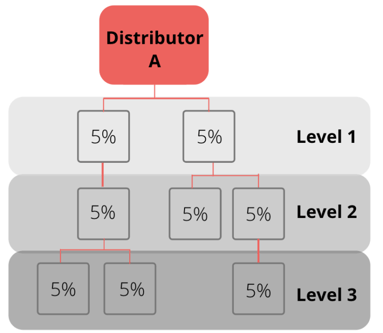
Every distributor that has an organization has levels, and a single recruit is usually on many different levels within her upline’s commission structure. That’s why levels go from top to bottom instead of bottom to top. Let’s look at the org chart below for an example. Distributor B is part of Distributor A’s organization, but she also has an organization of her own, made up of two levels. So, Distributor C is in both A and B’s organization—she’s on Level 1 in B’s downline and Level 2 of A’s downline.
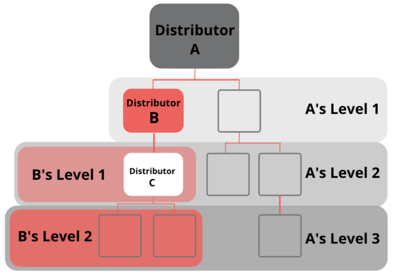
This is why level commission rules don’t require Distributor C to be at a certain level. Instead, levels are made from the top down. And leaders like A and B get commissions from levels underneath them. This tiered structure, made up of multiple levels of distributors, is what gives the term multi-level marketing (or MLM) its name. Because all MLMs have levels, level commissions can work well in virtually every comp plan.
How do Level Commissions Work?
Commissions from recruits
A level commission pays distributors a percentage earned from the sales of each level of recruits in their downline. All of the people that a distributor earns a commission from are part of that distributor’s payline. In its most basic form, each level would pay the same commission percentage for every level. So, in our example, Distributor A gets a 5% commission from the sales of each of her downline members.
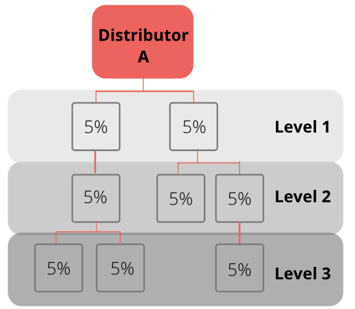
Rank qualifications
In most comp plans, distributors have to be at a certain rank to get their level commissions. Let’s say that Distributor A’s comp plan has that rule. This is how her level commission earnings would look like before she has a payline:
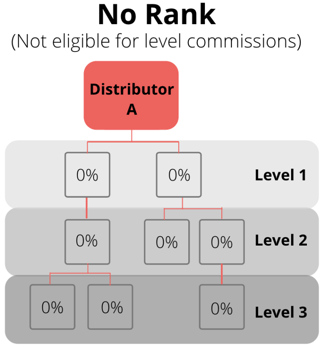
Even though she has three levels of sales, she can’t be paid from those levels of sales. If her plan has a rank requirement, she’ll have to meet it before she can earn her commission.
Once she has the right rank, she’ll start earning commissions from her payline. In most cases, a higher rank means more levels of commission eligibility. Here’s an example of what that would look like in Distributor A’s plan:
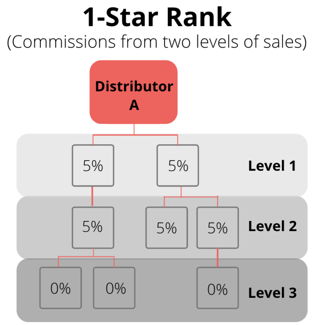
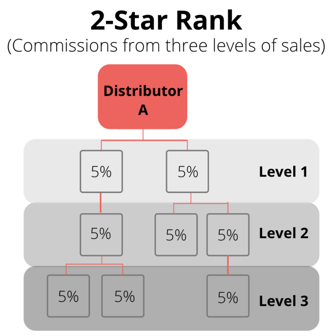
Payment limits
Distributors can earn commissions on as many downline levels as they qualify for, but companies only pay out what they’ve budgeted to spend for each purchase. Let’s say, in our example company, that 20% of every sale goes to commission payouts. For each level that she qualifies for, like in our earlier examples, Distributor A gets 5%. That means that this company’s level commission can only pay a commission to four levels of distributors for each purchase.
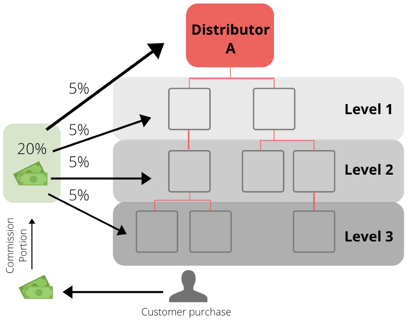
Compression
So far, this makes a lot of sense, right? But real life is usually a little more complicated than the scenarios we’ve been using. For example, what if there are recruits in Distributor A’s downline that aren’t selling anything? Let’s say that A is a 1-Star rank and qualifies for two levels of downline sales. But, in the last commission run, her first level recruits weren’t active and didn’t sell anything. In this scenario, Distributor A would only be paid from one level (Level 2) of her downline.
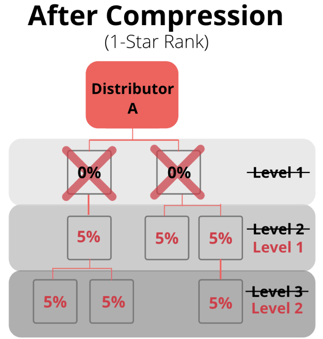
Distributor A will be pretty disappointed to miss out on her commissions. So, a lot of companies use something called “compression” to even things out. If a recruit is inactive during a commission run, that distributor is “compressed” out of the plan and all of the levels under her “slide up” to fill the inactive space. So, Distributor’s Level 2 becomes Level 1 and Level 3 becomes her Level 2.
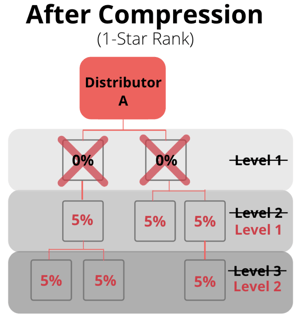
Common Variations
One of the reasons level commissions can work in pretty much every MLM compensation plan is because all they really need are, well, levels! Over time, certain versions of this commission type have become pretty common in the industry:
Unilevel commissions
Level commissions are the foundation of unilevel commissions (and compensation plans). The biggest difference between a unilevel and a level is that a unilevel usually has different commission percentages for different levels.
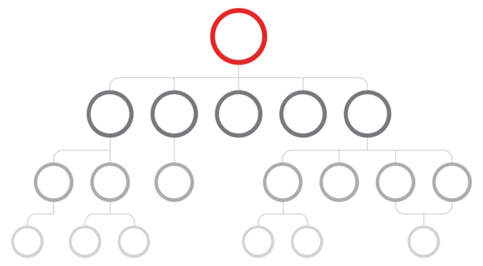
Generation or leader commissions
A generation commission is another common type of level commission. It’s one of the two commissions that make up the breakaway compensation plan and becomes available to distributors after they meet certain requirements (like having a high rank and a large organization).
The generation commission’s purpose is to continue providing income for leaders after they phase out of the differential commission. It works the same as a level commission but uses groups instead of levels. For every group under a breakaway leader, they get a cut of that group’s sales volume. It’s a great way to continue motivating and rewarding leaders who have built a big organization. (You can read about generation commissions here.)
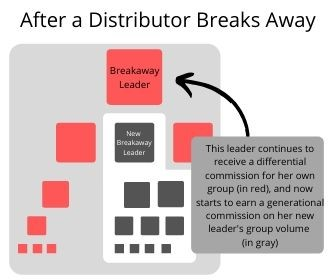
Matching commissions
In some compensation plans, levels play a smaller role in the overall compensation strategy. This is true for matching commissions, which pay on earnings instead of sales. They work really well for enroller downlines (common in binary compensation plans) that give distributors a reward for recruiting distributors that might not be close to them in their downline structure. If a company has a 10% matching enrolling commission and a downline recruit earns $1,000, her upline recruiter would earn $100. Matching commissions are a great way to fill compensation gaps.
Level Commission Pros and Cons
Now that we’ve gone over how levels work and some common ways they’re used, let’s talk about their benefits and disadvantages.
Pros
Easy to Understand
Because levels are the simplest commission type, they’re also the easiest to understand. This is a huge plus for your distributors, their recruits, your commission calculations team, and your customer service department. Less complications means less of an opportunity for error and confusion for all.
Stable Earnings Base
A lot of MLM commissions struggle to provide consistent paychecks. But, because level commission rules are so simple and distributors’ number of levels are pretty stable month to month, regular distributor earnings are a lot more dependable. For this reason, levels make a great foundational commission.
Spread the Wealth
Because level commissions are distributed into a pretty even upline pattern, they do a great job at rewarding a lot of upline distributors at once.
Cons
Lack of Urgency
Some commission types increase their paid commission percentage when a distributor reaches a higher qualification level. For example, a distributor will make 5% on her downline’s sales earnings until those earnings are, say, $500. Then, she can make 8%. This increased percentage is good motivation for a leader to train and help her downline to sell more product faster.
In a level commission, though, the percentage will always stay the same, whether the sales are $50 or $5,000. So, organizations aren’t as motivated to encourage rapid growth.
Stacking
Stacking can be a huge problem if you’re using a level commission, so you need to have good rules in place as soon as you can to prevent it. In essence, stacking means creating artificial levels in a distributor’s downline to amplify commission earnings. (You can learn more about it in our unilevel blog here.)
Conclusion
Levels are a great backbone commission for any direct selling compensation plan. Their ability to provide steady earnings and clear expectations have made them a mainstay in modern comp plans. As long as you watch out for stacking and add other incentives to supplement it, a level commission is a great addition to your plan.
Looking for more specialized commission help? Our commissions consulting team loves to talk strategy. Contact us here to learn more.





